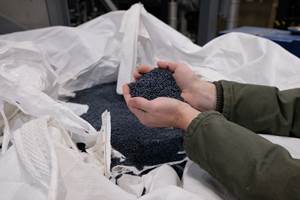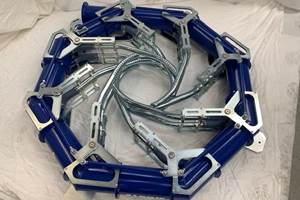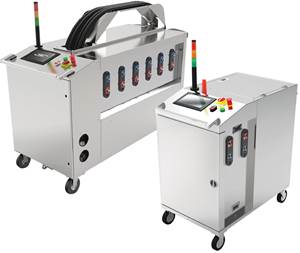Measuring Strain — Not Pressure — for Precision Injection Molding
A contact-free sensor measures the strain the melt imparts on the mold wall and promises precise, reproducible measurements with lower maintenance, longer service life and blemish-free parts.
Beyond giving unique insight to the potential quality of a part, cavity pressure data is essentially requisite for many components in markets like medical, with direct cavity pressure readings, where the sensor is on the surface of the cavity and in contact with the melt, the gold standard. That presence in the cavity provides the sensors with an unfettered reading of the pressure, but it comes at a cost, with continued direct exposure to the melt of abrasive materials, for instance, wearing them over time, as well as leaving a vestige or witness mark on the surface of the part. The blemishes might be small, but in applications where a class A surface finish is required, like lenses, they are unacceptable.
To overcome these challenges, sensors are sometimes placed behind an ejector pin or other mold component that is itself in direct contact with the melt. This positioning gets the sensor out of the cavity, but it can make them susceptible to false readings, if, for instance, the mounting hole isn’t fitted well to the ejector pin. These sensors can also be impacted by gases emitted by the plastic melt, which are often vented through ejector-pin channels. In addition, low-viscosity materials, like liquid silicone rubber (LSR), can leak through to the sensor, impacting the reading and over time requiring cleaning and maintenance. Dust and grime associated with being that close to the molding process can also impact the sensor and its readings over its service life.
One answer to these challenges that completely avoids contact, direct or indirect, with the melt: measuring the strain that the pressure of the melt imparts onto the mold’s walls. Kistler’s strain-based cavity pressure measurement is contact-free and uses piezoelectric sensors to generate what the company describes as “precise and reproducible values.”
Marko Marceta, product manager Plastics at Kistler, says that although this contact-free measurement method does not measure absolute cavity pressure values, it enables injection molders to draw accurate conclusions about them, so that measuring the strain over time produces a very similar measuring curve to other methods. Marceta notes that, more importantly, measuring strain generates reproducible curves, helping molders satisfy quality assurance and regulatory guidelines.
Ensconced behind the cavity wall, the sensors are protected from the plastic melt, as well as gases and outside contaminants, reducing maintenance requirements. They can also use more potential placements in the mold, with the ability to be positioned independently of the demolding direction and not requiring space close to the cavity. They only require one mounting hole where the sensor is placed and set with a predefined preload.
Kistler supports customers in sensor placement by performing a finite element analysis (FEA). This determines the maximum distance to the mold wall the sensor can be placed and still provide accurate and useful measurements. For the FEA, customers send in a 3D-CAD model showing where they want to place the sensor, and Kistler calculates what the actual sensitivity of the sensor in that position will be. In doing so, the company factors in both the strain on the metal and side forces.
Marceta says Kistler sensors have already been used to measure strain in other applications, such as machining, and the company applied that knowledge when developing the first piezoelectric strain sensor for injection molding. The resulting Type 9247A sensor has a circumference of 4.4 mm and has been applied by molders in the cosmetic and in the automotive industry for several years.
When the company shifted focus onto the medical industry, it sought to develop an even smaller sensor suitable for the compact molds used for products such as lenses, syringes and EpiPens. In 2018, Kistler launched the first ever version of a piezoelectric miniature longitudinal measuring pin, which it updated in late 2022. It’s updated version, 9239B miniature longitudinal pin has a circumference of 2.5 mm and can measures strain forces of up to 500N, with a sensitivity of 28.5 pC/N.
Marceta explains that one significant difference between the two contact-free sensors is the crystal that measures the strain. While the previous version applied a quartz crystal, the new version now features a PiezoStar crystal specifically grown by Kistler. This update raises the sensor’s sensitivity from 5.9 pC/N to 28.5 pC/N. Kistler says this enables the sensor to measure weaker signals reliably and precisely.
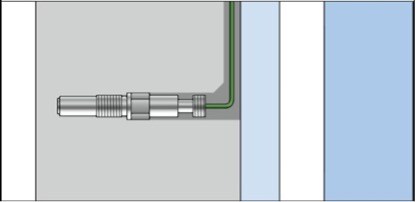
Residing behind the cavity wall, Kistler’s sensor measure the strain exerted on the wall to determine part quality, instead of direct pressure readings of the melt. Photo Credit: Kistler
Related Content
New Facility Refreshes Post-Consumer PP by Washing Out Additives, Contaminants
PureCycle prepares to scale up its novel solvent recycling approach as new facility nears completion.
Read MoreVariable-Diameter Air Ring Cools Film Above Frost Line
Tower-mounted adjustable ring adds cooling so that blown film can run at optimum line speeds with structures having soft inner skin layers that tend to block.
Read MoreHow Was K 2022 for Blow Molding?
Over a dozen companies emphasized sustainability with use of foam and recycle, lightweighting and energy savings, along with new capabilities in controls, automation and quick changeovers.
Read MoreSystem Offers 'Lights Out' Mold-Channel Cleaning & Diagnostics
New system automatically cleans mold-cooling lines—including conformal channels—removing rust and calcium, among other deposits, while simultaneously testing for leaks, measuring flow rate and applying rust inhibitor.
Read MoreRead Next
Wireless Strain Measurement Tracks Tie Bar Bending, Cavity Pressure
Gefran says the QE2008-W wireless strain measurement system uses a sampling rate of up to 1000 measurements/sec to measure clamping force, bending and cavity pressure profile.
Read MoreInjection Molding: Simplified Cavity-Pressure Control And Process/Production Monitoring
Cavity Eye provides innovative cavity sensors and data-transmission devices that plug into molds, machines, and auxiliaries.
Read MorePeople 4.0 – How to Get Buy-In from Your Staff for Industry 4.0 Systems
Implementing a production monitoring system as the foundation of a ‘smart factory’ is about integrating people with new technology as much as it is about integrating machines and computers. Here are tips from a company that has gone through the process.
Read More


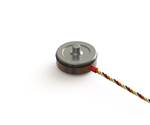











 (2).jpg;maxWidth=300;quality=90)




